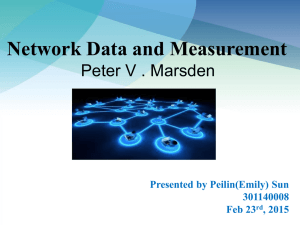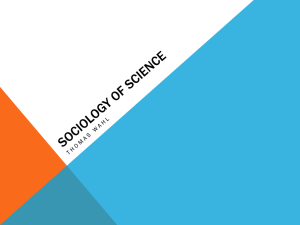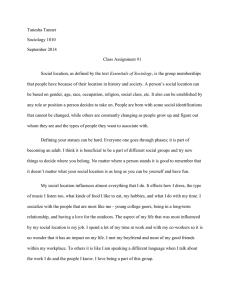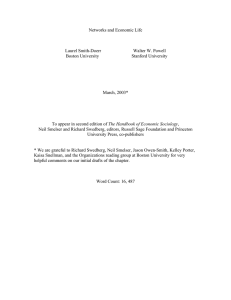Social Network Analysis
advertisement
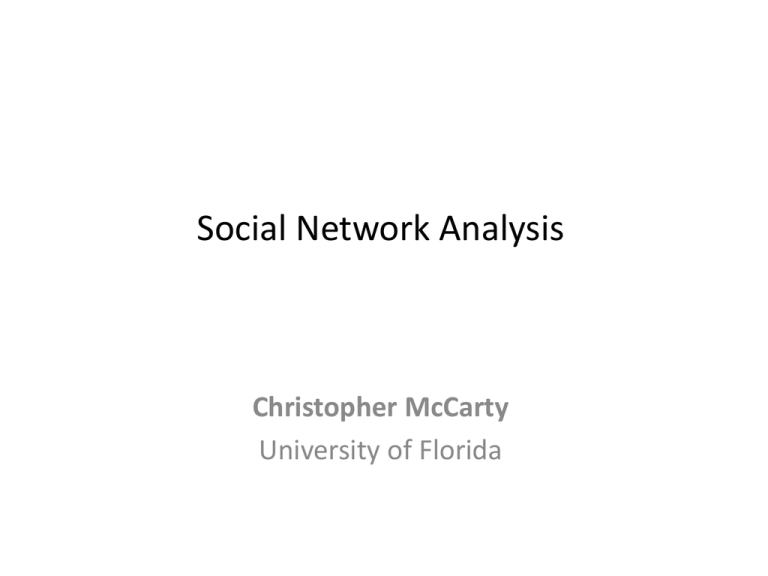
Social Network Analysis Christopher McCarty University of Florida Books • Social Network Analysis: A Handbook by John Scott, London: Sage (2000). • Social Network Analysis: Methods and Applications. Stanley Wasserman and Katherine Faust. Cambridge: Cambridge University Press (1994). • Social Networks and Health: Models, Methods and Applications by Tom Valente (2010) Oxford: Oxford University Press. • Understanding Social Networks: Theories, Concepts and Findings (2011) Charles Kadushin’s Oxford: Oxford University Pres. • The Development of Social Network Analysis: A Study in the Sociology of Science Linton C. Freeman, Empirical Press, Vancouver, BC (2004). • The SAGE Handbook of Social Network Analysis (2011) Eds. John Scott and Peter Carrington. London: Sage Publications Web Sites • www.insna.org -- International Network for Social Network Analysis • http://faculty.ucr.edu/~hanneman/nettext/ -Tutorial for UCINET/Netdraw • http://www.redes-sociales.net/ (Spanish social network listserv) Software • Ucinet (Whole networks) – • E-net (Batch processing of ego networks) – • http://www.casos.cs.cmu.edu/projects/ora/ Visone (Whole and Personal network analysis) – • http://ciknow.northwestern.edu/ ORA (Whole network analysis) – • http://stat.gamma.rug.nl/siena.html C-IKNOW(Online network data collection) – • (http://sourceforge.net/projects/egonet/) Vennmaker (Personal networks) Siena (Network modeling, longitudinal) – • (http://vlado.fmf.uni-lj.si/pub/networks/pajek/) Egonet (Personal networks) – • • (www.analytictech.com) Pajek (Whole networks, large networks) – • (www.analytictech.com) ($40 for students, $150 for faculty) http://visone.info/ Statnet – http://csde.washington.edu/statnet/ Journals • Social Networks • Connections • Journal of Social Structure • American Journal of Sociology, Social Science and Medicine, Journal of Mathematical Sociology, Organization Science, Social Forces, Gerontologist Sunbelt Conference • • • • • • • • 2001 – Budapest, Hungary – April 25-29 2002 – New Orleans, LA – March 1-9 2003 – Cancun, Mexico – March 1-9 2004 – Portoroz, Slovenia – May12-16 2005 – Redonda Beach, CA – February 16-20 2006 – Vancouver, Canada – April 25-30 2007 – Corfu, Greece – May 1-6 2008 – St. Pete Beach, FL – January 22-27 • • • • • 2009 – San Diego, CA – March 10-15 2010 – Riva gel Garda, Italy – June 29-July 4 2011 – St. Pete Beach, FL – February 8-13 2012 – Redonda Beach, CA – March 12-18 2013 – Hamburg, Germany – May 21-26 Social Network Analysis is the study of the pattern of interaction between actors Examples of actors and their networks • • • • • • • • • Children in a preschool Employees in an office Customers of AT&T mobile phone service NGOs working in the Amazon Companies in the Fortune 500 Countries in the European Union Baboons in a troupe Organisms in the Chesapeake Bay Web sites around the world Is SNA just a set of tools or is it a theoretical approach? See: http://www.insna.org/PDF/Sunbelt/3_KeynotePDF.pdf • Social Capital, Structural Holes, Simmelian ties • Strong and weak ties • Small world • Scale-free networks • Network diffusion Social Capital • “…the ability of actors to secure benefits by virtue of membership in social networks or other social structures” (Portes 1998) • Alejandro Portes (1998) SOCIAL CAPITAL: Its Origins and Applications in Modern Sociology, Annual Review of Sociology 1998. 24:1–24 • Ron Burt (2004) Structural Holes and Good Ideas, American Journal of Sociology 110: 349–399 David Krackhardt (1999) The ties that torture: Simmelian tie analysis in organizations, Research in the Sociology of Organizations 16: 183-210 Structure matters (but is not always enough) • In some contexts structure is a necessary, but not sufficient, condition for social capital • The most beneficial structural position may depend on the topic – Job seeking – Social support • Social network evaluation and intervention does not always mean you should connect the dots – Facebook model is to suggest connections – Sometimes there are reasons for not connecting Strong and weak ties • The most beneficial tie may not always be the strong ones • Strong ties are often connected to each other and are therefore sources of redundant information • Mark Granovetter (1973) The strength of weak ties American Journal of Sociology 78-1361-1381. Small world phenomenon • Being linked, seemingly by chance, through someone via a friend or acquaintance • Stanley Milgram (1967)The Small World Psychology Today 2:60–67. • Peter D. Killworth, H. Russell Bernard and Christopher McCarty (1984) Measuring Patterns of Acquaintance Current Anthropology 25:381-397 • Duncan Watts and Steven Strogatz (1998) Collective dynamics of 'small-world' networks Nature 393 (6684): 409–10 Scale Free Networks • Scale free refers to the power law structure of networks as the number of actors increases • Networks tend to form hubs • Entry of physicists into SNA • Albert-László Barabási and Réka Albert (1999) Emergence of scaling in random network. Science, 286:509-512. Network Diffusion • Network structures can often aid or impede the flow of information and the adoption of innovations • Diffusion of innovation is the basis for peer to peer network interventions • Coleman, James, Elihu Katz, and Herbert Menzel. 1957. The diffusion of innovation among physicians. Sociometry. 20:253-270. • Valente, Thomas W. 1996 “Social network thresholds in the diffusion of innovations” Social Networks 18:69-89. • Klovdahl, A. S. (1985). Social networks and the spread of infectious diseases: The AIDS example. Social Science Medicine, 21(11), 1203-1216. Two kinds of Social Network Analysis Whole (Complete, Sociocentric) Network Analysis • Focus on interaction within a group • Boundary defines social space • Collect data from members of a group about their ties to other group members Personal (Egocentric) Network Analysis • Focus on effects of network on individual attitudes, behaviors and conditions • Use attributes of personal network to represent social context • Collect data from respondent (ego) about interactions with network members (alters) Sociocentric Network Data From Graduate Anthropology Course • Three network components • Beth is most degree central • Amber is most between central • Thomas and Kent are structurally equivalent • Removal of David maximizes network fragmentation Boundary definition • Boundaries can be defined: – Geographically (a village) – Socially (an organization) – Through connections (snowball) • The idea is that actors within the boundary are in some way affected by their social position • This excludes the effects from those outside the boundary Missing data • In whole networks responses by others about nonrespondents can capture structure • 70% will in many cases be enough • Gueorgi Kossinets (2006) Effects of missing data in social networks. Social Networks 28: 247–268. • Costenbader, E. & Valente, T. W. (2004). The stability of centrality when networks are sampled. Social Networks. Two kinds of Social Network Analysis Whole (Complete, Sociocentric) Network Analysis • Focus on interaction within a group • Boundary defines social space • Collect data from members of a group about their ties to other group members Personal (Egocentric) Network Analysis • Focus on effects of network on individual attitudes, behaviors and conditions • Use attributes of personal network to represent social context • Collect data from respondent (ego) about interactions with network members (alters) Personal network interview • Identify a population • Select a sample of respondents • Ask questions about respondent • Elicit network members • Ask questions about each network member • Ask respondent to evaluate ties between network members Personal Network Composition Alter summary file Name Closeness Relation Sex Age Race Where Live Year_Met Joydip_K 5 14 1 25 1 1 1994 Shikha_K 4 12 0 34 1 1 2001 Candice_A 5 2 0 24 3 2 1990 Brian_N 2 3 1 23 3 2 2001 Barbara_A 3 3 0 42 3 1 1991 Matthew_A 2 3 1 20 3 2 1991 Kavita_G 2 3 0 22 1 3 1991 Ketki_G 3 3 0 54 1 1 1991 Kiran_G 1 3 1 23 1 1 1991 Kristin_K 4 2 0 24 3 1 1986 Keith_K 2 3 1 26 3 1 1995 Gail_C 4 3 0 33 3 1 1992 Allison_C 3 3 0 19 3 1 1992 Vicki_K 1 3 0 34 3 1 2002 Neha_G 4 2 0 24 1 2 1990 . . . . . . . . . . . . . . . . . . . . . . . . Personal network composition variables • Proportion of personal network that are women • Average age of network alters • Proportion of strong ties • Average number of years knowing alters Personal Network Structure Alter adjacency matrix Joydip_K Shikha_K Candice_A Brian_N Barbara_A Matthew_A Kavita_G Ketki_G . . . Joydip_K 1 1 1 1 0 0 0 0 . . . Shikha_K 1 1 0 0 0 0 0 0 . . . Candice_A 1 0 1 1 1 1 1 1 . . . Brian_N 1 0 1 1 1 1 1 1 . . . Barbara_A 0 0 1 1 1 1 0 0 . . . Matthew_A 0 0 1 1 1 1 1 1 . . . Kavita_G 0 0 1 1 0 1 1 1 . . . Ketki_G 0 0 1 1 0 1 1 1 . . . . . . . . . . . . . . . . . . . . . . . . . . . . . . . . . . . . . . . Personal network structural variables • Average degree centrality (density) • Average closeness centrality • Average betweenness centrality • Core/periphery • Number of components • Number of isolates Boundary definition for personal networks • Facebook – West Africa and Asia • Time – First grade teacher • Require mutual recognition – Book author • Living – Dead relative (Genogram) – Jesus Two categories of data collection • One mode data – Actors by actors • Examples of one mode data collection – Survey; E-mail; Telephone calls; Observation of interaction • Two mode data – Actors by events • Examples of two mode data collection – Attendance at parties, meetings, funerals; Purchase of items; Reading particular authors Kinds of data Whole Complete Sociocentric One mode Two mode Personal Egocentric Example 1 One mode - Whole network University – Water Management District interaction • Objective: Understand structure of interaction between academic and applied scientists • Procedure 1: Bound universities by those published in journals in St. Johns Water Management District library in 2008 • Procedure 2: Bound WMD by employee e-mails on web sites • Procedure 3: Web survey with letter and $1 incentive to all 705 actors • Response: 332 completed surveys Visualization of University-WMD network Example 2 One mode - Personal network Acculturation study • Objective: Test social network compositional and structural variables as proxies for acculturation • Procedure 1: Interviewed 535 migrants in Barcelona and New York City • Procedure 2: Each respondent listed 45 network alters • Procedure 3: Respondents provided twelve pieces of information about each alter • Procedure 4: Respondents evaluated all 990 unique alter-alter ties Visualization of the networks of two sisters Label = Country of origin, Size = Closeness, Color = Skin color, Shape = Smoking Status • Mercedes is a 19-year-old second generation Gambian woman in Barcelona • Laura is a 22-year-old second generation Gambian woman in Barcelona • She is Muslim and lives with her parents and 8 brothers and sisters • She is Muslim and lives with her parents and 8 brothers and sisters • She goes to school, works and stays home caring for her siblings. She does not smoke or drink. • She works, but does not like to stay home. She smokes and drinks and goes to parties on weekends. Example 3 Two mode - Whole network Southern women • Objective: To understand the network structure of the debutante network in a Southern town in the 1940s • Procedure: Observe which of the 14 annual balls each of the 18 women attended Two mode data matrix Visualization of two mode data Example 4 Two mode - personal network Relation categories in Thailand • Objective: Discover mutually exclusive and exhaustive categories in a language for how people know each other to be used on a network scale-up survey instrument Procedure 1: Twenty one respondents freelist in Thai ways that people know each other Procedure 2: Twenty one respondents list 30 people they know and apply 26 most frequently occurring categories colleague ปอนด์ นุช เพ็ ญ พี่ยู หมี อาจารย์นิ อาจารย์อมรา พี่นด ิ มด พี่จม ุ๋ พี่ภา พี่จวิ่ น ้าช่วย อาจารย์มานพ วรา โจ ้ สุทป ี พี่ยาว พี่เกด ส ้ม เกด พี่เหว่า เอ๋ย ปิ ง เล็ก น ้าม่อน ป้ าขวด นุ ้ย household 0 1 0 0 1 1 1 1 1 0 1 1 1 0 0 0 1 0 0 0 1 1 0 0 0 0 0 0 neighbour 1 0 0 0 0 0 0 0 0 0 0 0 0 0 0 0 0 0 0 0 0 0 0 0 0 0 0 0 sport club/ park 0 0 1 0 0 0 0 0 0 0 0 0 0 0 0 0 0 0 0 0 0 0 0 0 0 0 0 0 meeting 0 0 0 0 0 0 0 0 0 0 0 0 0 0 0 0 0 0 0 0 0 0 0 0 0 0 0 0 0 1 0 0 1 1 1 0 1 1 1 1 0 1 0 0 0 1 0 0 0 0 1 1 0 0 0 0 relatives temple/ church same community 1 0 0 0 0 0 0 0 0 0 0 0 0 0 0 0 0 0 0 0 0 0 0 0 0 0 0 0 0 0 0 0 0 0 0 0 0 0 0 0 0 0 0 0 0 0 0 0 0 0 1 0 1 0 0 0 0 0 0 0 0 0 0 0 0 0 0 0 0 0 0 0 0 0 0 0 0 0 0 0 0 0 0 0 Affiliation from all respondents Graph of relationship between knowing categories
